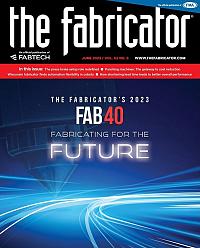Editor
- FMA
- The Fabricator
- FABTECH
- Canadian Metalworking
Categories
- Additive Manufacturing
- Aluminum Welding
- Arc Welding
- Assembly and Joining
- Automation and Robotics
- Bending and Forming
- Consumables
- Cutting and Weld Prep
- Electric Vehicles
- En Español
- Finishing
- Hydroforming
- Laser Cutting
- Laser Welding
- Machining
- Manufacturing Software
- Materials Handling
- Metals/Materials
- Oxyfuel Cutting
- Plasma Cutting
- Power Tools
- Punching and Other Holemaking
- Roll Forming
- Safety
- Sawing
- Shearing
- Shop Management
- Testing and Measuring
- Tube and Pipe Fabrication
- Tube and Pipe Production
- Waterjet Cutting
Industry Directory
Webcasts
Podcasts
FAB 40
Advertise
Subscribe
Account Login
Search
Want better manufacturing leaders? Build character
Care about people first
- By Lincoln Brunner
- June 29, 2023
- Article
- Shop Management
When Mack Story gets a call from a CEO asking for his help to change a company’s culture, his thoughts and advice turn to one word: Character.
That word, character, gets a lot of lip service, mainly in conversations about “soft skills.” But character means something deeper and more binding than emotional intelligence, Story believes. To him, character revolves around values—specifically what the CEO and the company’s leadership team value. That set of values inevitably flows down from the top of the company, creating and defining the very culture that the CEO wants to change.
The implications are clear.
“Quite often, I get top leaders who want to transform their culture, but they haven’t even thought about transforming their own values,” said Story, author and owner of Blue-Collar Leadership, a consultancy based in the Atlanta area. “The culture of the organization is exactly where their values have led it.”
Leading Versus Managing
One recent Story client in the automotive industry brought him in for more than two weeks recently. The CEO wanted Story to guide more than 100 company leaders, from directors up to the C-suite, through a study of his book, “Blue-Collar Leadership & Supervision.” Why? Because most of them had never been through any leadership development. As a result, many of those bosses had inadvertently suffered such a lack of relational capital with their employees that they lost a lot of respect from the rank and file, who viewed them as dictators they resented instead of leaders they trusted.
“You don’t work for high-impact leaders,” Story wrote in his supervision book. “You work with them. They know it, and you know it. You don’t work with managers. You work for them. They know it, and you know it.”
The difference is that leadership is about relationships, while management is about tasks. Leadership builds trust; mere management, because it’s non-relational, often creates mistrust. And that’s where bosses in that automotive company found themselves tripping.
“A lot of the leaders were not approachable,” Story recalled. “They had an old-school management mindset. People who haven’t had leadership development, unless they’re just naturally good leaders—which most people are not—most of them manage people just like they do things and processes. There’s no connection. There’s no relationship.”
In Story’s mind, gaining that trust requires people in leadership to adopt a risky posture: Vulnerability.
Leading Through Vulnerability
Story, in fact, focuses on the concept of vulnerability because of how well he’s seen it work in trust-building. Story offered an example from his experience leading groups of 20 people per week for many successive weeks through lean leadership certification.
“One guy in there, on Wednesday, he was still resistant,” Story recalled. “He wouldn’t say anything. He just kept crossing his arms. He wouldn’t even look up at me. He just sat there for the whole eight-hour day.”
A key tenet of vulnerability, to Story, is seeking to understand before being understood. So, sincerely believing there was something he didn’t know that could help fix the situation, he walked over to the man, put his hand on his shoulder, and apologized to him in front of everyone for not knowing whatever it was that was keeping the man from engaging in the training. When he returned to the front of the table from where he was speaking, that one gesture got the man to open up.
"That guy uncrossed his arms and looked at me and said, ‘What I’m going through is not your fault,’” Story recalled. “He said, ‘I’m going through a divorce. That’s what my thoughts are on every day.’
“And you know, nobody knew that.” Story said. “But because I gave him room to breathe, and I took responsibility for his behavior, he actually took responsibility for his behavior and shared with us why he was being that way. The next break, though, all of his co-workers were offering him support.”
No Instant Solution
Some companies Story works with want instant change, but it doesn’t work that way, he said. It’s a purposeful process.
One example he points to often is one of his marquee clients: Chick-fil-A. The privately owned fast food chain’s sandwiches and drive-through service have made it a roaring success, but it’s the company’s customer service that’s made it legendary. And it does it with an army of Gen Z employees who supposedly have no work ethic.
“A lot of people say young people don’t want to work, and that’s one reason I tell them about Chick-fil-A—it's full of young people,” Story said. “And they’ll say, ‘Well, that’s a different business—we aren’t in the restaurant business.’ And then I’ll say, ‘Well, what about the other restaurants? Are they different? Is their service different—the way that people talk to each other, the way they talk to the guests, the cleanliness of the store, the language they use?’ They say, ‘Well, yeah, it’s a lot different at the other places.’
“I say, ‘So they’re in the same industry. These people have these other businesses, and they have billions of dollars. They can buy the same locations; they can buy the same materials. They can build a nice building. They can buy good ingredients, and they can pay people whatever they want to pay them. But you can’t buy character. You’ve got to build it. And most people aren’t willing to build it.”
People Are the ROI
Story said that a lot of people who lead businesses both large and small come to him wondering what the return on investment is going to be for his training—how it will immediately benefit the bottom line. He would say that’s the wrong question to ask.
“If a leader ever talks to me about ROI, I know … I’m not the person to help them,” Story said. “They’re worried about the money. So, that conversation doesn’t go very far.
“People who aren’t worried about the money are the ones who do the best job at this. And the reason they do it the best is because they’re worried about the people. They genuinely care about the people. They’re the people who get us in the room. They want to help their people have a better life at home and at work. The ROI for them is, they’re helping people. And their people respond to that really, really quick.”
About the Author

Lincoln Brunner
2135 Point Blvd.
Elgin, IL 60123
(815)-227-8243
Lincoln Brunner is editor of The Tube & Pipe Journal. This is his second stint at TPJ, where he served as an editor for two years before helping launch thefabricator.com as FMA's first web content manager. After that very rewarding experience, he worked for 17 years as an international journalist and communications director in the nonprofit sector. He is a published author and has written extensively about all facets of the metal fabrication industry.
subscribe now

The Fabricator is North America's leading magazine for the metal forming and fabricating industry. The magazine delivers the news, technical articles, and case histories that enable fabricators to do their jobs more efficiently. The Fabricator has served the industry since 1970.
start your free subscription- Stay connected from anywhere

Easily access valuable industry resources now with full access to the digital edition of The Fabricator.

Easily access valuable industry resources now with full access to the digital edition of The Welder.

Easily access valuable industry resources now with full access to the digital edition of The Tube and Pipe Journal.
- Podcasting
- Podcast:
- The Fabricator Podcast
- Published:
- 04/16/2024
- Running Time:
- 63:29
In this episode of The Fabricator Podcast, Caleb Chamberlain, co-founder and CEO of OSH Cut, discusses his company’s...
- Trending Articles
Tips for creating sheet metal tubes with perforations

JM Steel triples capacity for solar energy projects at Pennsylvania facility

Are two heads better than one in fiber laser cutting?

Supporting the metal fabricating industry through FMA

Omco Solar opens second Alabama manufacturing facility

- Industry Events
16th Annual Safety Conference
- April 30 - May 1, 2024
- Elgin,
Pipe and Tube Conference
- May 21 - 22, 2024
- Omaha, NE
World-Class Roll Forming Workshop
- June 5 - 6, 2024
- Louisville, KY
Advanced Laser Application Workshop
- June 25 - 27, 2024
- Novi, MI



























